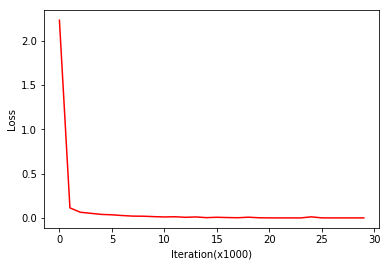一丶作业要求
| 标题 | 内容 |
|---|---|
| 这个作业属于哪个课程 | 班级博客的链接 |
| 这个作业的要求在哪里 | 作业要求的链接 |
| 我在这个课程的目标是 | 完成一个完整的项目,学以致用 |
| 这个作业在哪个具体方面帮助我实现目标 | 帮助我复习DNN |
二、解决方法
1) 将模型准确度调整至>97%
其实不修改任何参数只增加epoch就可以很容易超过97%准确率了
1)考虑到梯度下降是在太慢了,对原代码应用了AdamOptimizer。
def adam(w, dw, config=None):
if config is None: config = {}
#config.setdefault('learning_rate', 1e-3)
config.setdefault('beta1', 0.9)
config.setdefault('beta2', 0.999)
config.setdefault('epsilon', 1e-8)
config.setdefault('m', np.zeros_like(w))
config.setdefault('v', np.zeros_like(w))
config.setdefault('t', 0)
next_w = None
config['t']+=1
config['m'] = config['beta1']*config['m']+(1-config['beta1'])*dw
config['v'] = config['beta2']*config['v']+(1-config['beta2'])*np.square(dw)
mt = config['m']/(1-np.power(config['beta1'], config['t']))
vt = config['v']/(1-np.power(config['beta2'], config['t']))
next_w = w - config['learning_rate']*mt/np.sqrt(vt+config['epsilon'])
def update3(dict_Param, dict_Grads, learning_rate, config):
for p, w in dict_Param.items():
dw = dict_Grads["d"+p]
config[p]['learning_rate'] = learning_rate
next_w, next_config = adam(w, dw, config[p])
dict_Param[p] = next_w
config[p] = next_config
return dict_Param, config
#主函数补充
config = {'W1':{}, 'W2':{}, 'W3':{}, 'B1':{}, 'B2':{}, 'B3':{}}
#在Train 补充超参数 config即可2)在Train中增加了学习率衰减
for epoch in range(max_epoch):
learning_rate = learning_rate*0.953)用了Relu加快收敛
具体的
def Relu(z):
mask = z<0
a = z.copy()
a[z<0] = 0
return a
def forward3(X, dict_Param):
W1 = dict_Param["W1"]
B1 = dict_Param["B1"]
W2 = dict_Param["W2"]
B2 = dict_Param["B2"]
W3 = dict_Param["W3"]
B3 = dict_Param["B3"]
Z1 = np.dot(W1,X) + B1
#A1 = Sigmoid(Z1)
A1 = Relu(Z1)
Z2 = np.dot(W2,A1) + B2
#A2 = Tanh(Z2)
A2 = Relu(Z2)
Z3 = np.dot(W3,A2) + B3
A3 = Softmax(Z3)
dict_Cache = {"Z1": Z1, "A1": A1, "Z2": Z2, "A2": A2, "Z3": Z3, "A3": A3, "Output": A3}
return dict_Cache
def backward3(dict_Param,cache,X,Y):
W1 = dict_Param["W1"]
W2 = dict_Param["W2"]
W3 = dict_Param["W3"]
A1 = cache["A1"]
A2 = cache["A2"]
A3 = cache["A3"]
Z1 = cache['Z1']
Z2 = cache['Z2']
m = X.shape[1]
dZ3= A3 - Y
dW3 = np.dot(dZ3, A2.T)/m
dB3 = np.sum(dZ3, axis=1, keepdims=True)/m
dA2 = np.zeros_like(Z2)
dA2[Z2>0] = 1
# dZ2 = W3T * dZ3 * dA3
#dZ2 = np.dot(W3.T, dZ3) * (1-A2*A2) # tanh
dZ2 = np.dot(W3.T, dZ3)*dA2
dW2 = np.dot(dZ2, A1.T)/m
dB2 = np.sum(dZ2, axis=1, keepdims=True)/m
dA1 = np.zeros_like(Z1)
dA1[Z1>0] = 1
# dZ1 = W2T * dZ2 * dA2
#dZ1 = np.dot(W2.T, dZ2) * A1 * (1-A1) #sigmoid
dZ1 = np.dot(W2.T, dZ2)*dA1
dW1 = np.dot(dZ1, X.T)/m
dB1 = np.sum(dZ1, axis=1, keepdims=True)/m
dict_Grads = {"dW1": dW1, "dB1": dB1, "dW2": dW2, "dB2": dB2, "dW3": dW3, "dB3": dB3}
return dict_Grads2)博客中给出参数列表和对应值
进行了最优参数搜索,列举了9种不同的参数
learning_rate = 0.001887
batch_size = 64
m_epoch = 30
| hidden1, hidden2 | accuracy |
|---|---|
| 128, 50 | 0.9787 |
| 128, 32 | 0.9819 |
| 128, 16 | 0.9812 |
| 100, 50 | 0.9821 |
| 100, 32 | 0.983 |
| 100, 16 | 0.9799 |
| 64, 50 | 0.982 |
| 64, 32 | 0.9805 |
| 64, 32 | 0.9815 |
3)给出最终准确度结果
hard_voting and soft_voting
选取所有模型进行hard_voting,选取表现好的4个模型进行soft_voting
from sklearn.metrics import accuracy_score
from scipy.stats import mode
#hard_voting
arr[str(i)+str(j)] = forward3(X, dict_Param)['Output']
ense = np.zeros((10000, 9))
for i, (key,value) in enumerate(arr.items()):
ense[:,i] = np.argmax(value, axis=0)
accuracy_score(mode(ense[:,:], axis=1)[0], y)
#output 0.9852
#soft_voting
lis = []
confidence_matrix = np.zeros((9, 10000))
for i, (key,value) in enumerate(arr.items()):
confidence_matrix[i, :]=(value[np.argmax(value, axis=0),np.arange(10000)])
confidence_matrix = confidence_matrix[[1,3,4,6],:]
accuracy_score(ense[:,[1,3,4,6]][np.arange(10000), np.argmax(confidence_matrix, axis=0)], y)
#output 0.98554)损失图
